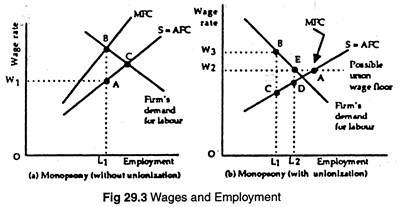The below mentioned article provides a quick notes on Union Power, Employment and Monopoly.
There is wide agreement among economists that unionization is necessary to protect employees from the power of employers because employees are almost always at a disadvantage in bargaining. However, in a market characterized by a large number of employers, the interest of employees will be automatically protected by competition among employers.
In a highly competitive environment each employer must pay the market wage to employees to keep them from shifting to higher paying alternative employers. This is because in a modern society labour is highly mobile. Most employees sell their services in a labour market in which there are many employers.
However, some workers are constrained to sell their services in a different situation—a situation in which there is only a single employer of labour, at least for the specific skill category of labour supplied by the workers. For example, if a single employer—perhaps a textile manufacturer—dominates the labour market of a small town, local workers may have few alternative employment opportunities.
ADVERTISEMENTS:
Analysis of labour markets under conditions of monopsony is interesting because it enables us to understand situations in which the market is dominated by a single employer or a small number of employers. Monopsony refers to a market situation in which there is a single buyer of a particular type of labour such as service of carpenters.
We know that a monopolist can make excess profits by restricting output and charging a price above the marginal cost of production. An exactly opposite strategy is followed by a monopsonist—the monopolist buyer of labour.
Since the alternatives open to workers is limited, the monopolist buyer will be able to make profit by restricting the purchase of a specific skill category of labour and paying a price (wage rate) that is less than the marginal revenue generated by this labour. Fig. 3 explains and illustrates the impact of monopsony in the labour market.
Since the monopsonist is the sole purchaser of labour, the supply curve of labour faced by it is the market supply curve of labour. Like all other supply curves the labour-supply curve will be upward sloping because higher wages are to be paid to attract additional workers.
ADVERTISEMENTS:
It will now be assumed that both the old and the new employees will be paid the higher wage rates if more workers are to be hired. Here the marginal factor cost (MFC) curve indicates the marginal cost of labour to the monopolist.
The marginal factor cost of labour will exceed the wage rate because higher wages necessary to attract each additional worker, must be paid to all employees-old and new. As illustrated in Fig. 3, this means that the monopsonist’s MFC curve will be steeper than the supply curve of labour.
A profit-maximizing monopolist will continue to employ additional workers so long as marginal revenue product of labour (i.e., the additional revenue that can be made by selling the output produced by the last worker) exceeds the marginal factor cost of labour. Thus it will choose to employ L1 workers because by doing so it will be able to equate MRPL with MFCL or the marginal wage which is w1.
ADVERTISEMENTS:
Thus a wage rate of w1 is just sufficient to attract E1 workers. If the monoposonist seeks to employ more workers, it would cost the monopsonist (MFC) more to hire an extra worker than what the worker would add to total revenue. To avoid this cost, the monopolist firm will hire fewer employees than it would if it were the only buyer in the labour market.
Fig. 3 illustrates what would happen if a union established a minimum wage — W2, for example—for a monopsonist. This minimum wage would prohibit the monopsonist from paying low wages even if employment falls to a low level. In such a situation the union would confront the employer with the supply curve w2 AS.
In essence, the minimum wage would become the monoposonist’s marginal factor cost curve until the minimum wage intersected the labour supply curve at A. So long as the MFC of additional units of labour was less than the firm’s demand curve, the firm would find it profitable to employ the additional workers. Thus if a trade union imposed a minimum wage rate of w2, the monopsonist would expand employment to L2.
In such a situation unionization would result in both higher wages and an expansion in employment. If, however, the union raised the wage rate above, w3, employment would fall below L1, the level of employment of a monopsonist (not facing a union). But, for any minimum wage below w3, the monopsonist would expand the level of employment beyond L1.
While discussing the impact of unions, economists generally focus on wages and employment. However, evidence suggests that unions have been able to significantly influence labour’s share of total income. The truth is that rising production, not union power, is the primary source of increasing real wages of modern industrial society.
In fact, the most important contribution of trade unions in highly industrialized nations like the U.S.A., Germany, Japan, etc. has been their role in defending employees against a sense of powerlessness, unimportance, alienation, and insecurity.
To conclude with Grawtney and Stroup, “A union provides the worker with a strong defence against the whim, arbitrary actions, and excesses of a foreman or management representative. Because of the power of the union, even in cases where only a portion of workers are unionized, management has a greater incentive to treat workers with dignity and to grant them a sense of individual importance. These worker benefits are, for the most part, non-pecuniary and difficult to measure, but they are nevertheless extremely important.”
